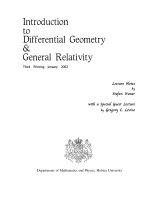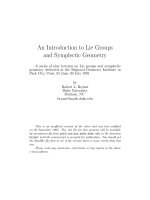Introduction to coastal engineering and management advanced series on ocean engineering j william kamphuis
Bạn đang xem bản rút gọn của tài liệu. Xem và tải ngay bản đầy đủ của tài liệu tại đây (22.87 MB, 470 trang )
I~RODUCTION
TO
COASTAL ENGI
AND
GE~ENT
Advanced Series on Ocean ~ n ~ i n e er ~Volume
~ g 16
INTRO~UCTIONTO
COASTAL E N ~ I N E E ~ N G
AND ~ N A G E ~ E N T
J. William ~ ~ r n p h u ~ ~
Queen’s University, Canada
WpVVorld Scientific
Singapore *NewJersey* London 4Hong Kong
~ u b l i s by
~d
World Scientific Publishing Co. Pte. Ltd.
P 0Box 128, Farrer Road, Singapore 912805
USA ofice: Suite IB, 1060 Main Street, River Edge, NJ 07661
LIK offie: 57 Shelton Street, Covent Garden, London WC;?H 9HE
British Library Cataloguing-in-PublicationRab
A catalogue record for this book is available from the British Library.
~
R
O TO COASTAL
~
~ E ~~
G ~ ~ AND
~N NM AG~ A ~ E M ~ N T
C o ~ ~ gQh2000
t by Worfd Scientific Pubiishing Co. Pte.Ltd.
All rights resewed. This book, or parts thereoj m y not be reproduced in anyform or by any means,
electronic or m e c ~ n ~ c aincludingpho~ocopying,
l,
recording or any i ~ ~ o r ~storage
t ~ o and
n retrieval
system now known or to be invented, withour written permissionfrom the Publisher.
For phot~opyingof material in this volume, please pay a copying fee through the Copyright
Clearance Center, Inc., 222 Rosewood Drive, Danvers, MA 01923, USA. €nthis case permission to
photocopy is not required from the publisher.
ISBN 981-02-3830-4
ISBN 981-02-4417-7 (pbk)
Printed in Singapore.
ADVANCED SERIES
ON OCEAN ENGINEERING
Series Editor-in-Chief
Philip L- F Liu (Come// U n i ~ ~ ~ i ~ )
Vol. 1 The Applied Dynamics of Ocean Surface Waves
by Chiang C Mei (MU)
Vol. 2 Water Wave Mechanics for Engineers and Scientists
by Robert G Dean (Univ. Florida) and Robert A Datrymple
(Univ. Delaware)
Vol. 3 Mechanics of Coastal Sediment Transport
by J0rgen f r e d s ~ eand Rolf Deigaard (Tech. Univ. Denmark)
Vol. 4 Coastal Bottom Bounda~Layers and Sediment Transport
by Peter Nietsen (Univ. Queensland)
Vol. 5 Numerical Mode~ingof Ocean Dynamics
by Zygmunt Kowalik (Univ. Alaska) and T S Murty (lnsf. Ocean Science, BC)
Vol. 6 Kalman Filter Method in the Analysis of Vibrations Due to Water Waves
by Piofr Wilde and Andnej Kozakiewicz (Inst. Hydroengineering, Polish
Academy of Sciences)
Vol. 7 Physical Models and Laboratory Techniques in Coastal Engineering
by Steven A. Hughes (Coastal Engineering Research Center, USA)
Vol. 8 Ocean Disposal of Wastewater
by fan R Wood (Univ. Canterbuty), Robert G Bell (National Institute of Water
& Atmospheric Research, New Zealand) and David 1 Wilkinson (Univ.
New South Wales)
Vol. 9 Offshore Structure Modeling
by Subrata K, Chakrabarti (Chicago Bridge & Iron Technical
Services Go., USA)
Vol. 10 Water Waves Generated by Underwater Explosion
by Bernard f e Mdhautd and Shen Wang (Univ. Miami)
Vol. 11 Ocean Surface Waves; Their Physics and Prediction
by Stanislaw R Massel (Australian Inst. of Marine Sci)
Vol. 12 Hydrodynamics Around Cylindrical Structures
by B Mu~/u
Sumer and J0rgen Freds~e(Tech. Univ. of den ma^)
Vol. 13 Water Wave Propagation Over Uneven Bottoms
Part I - Linear Wave Propagation
by Maarten W ~ingemans(Delft Hydrauli~)
Part II - Non-linear Wave Propagation
by Maarten W Dingemans (Delft Hydraulics)
Vol. 14 Coastal Stabilization
by Richard Silvesfer and John R C Hsu (The Univ. of Western Australia)
Voi. 15 Random Seas and Design of Maritime Structures (2nd Edition)
by Y ~ h j mGoda
i
(Yokohama National Unive~ity)
Vof. 16 Introduction to Coastal Engineering and Management
by J William Kamphuis (clueen’s Univ.)
Forthcoming tifles:
Tsunami Run-Up
by Philip L- F Liu (Cornell Univ.), Costas Synolakis (Univ. Southern California),
Harry Yeh (Univ. Washington) and Nobu Shut0 (Tohoku Univ.)
Beach Nourishment: Theory and Practice
by Robert G Dean (Univ. Florida)
to all students
Preface
What can I say? This book is really not about facts and formulas. It is about
learning and understanding. It is about diligence and care, about stewardship of a
precious resource. It was essentially 32 years in the making. It was developed from
lecture notes for an introductory course and its stated purpose is to bridge the gap
between an eager student who knows nothing about coastal engineering and
management, and the available literature. My hope is that this book also finds its
way on the bookshelves of the practitioners, as a handy reference to those “first
things we all need to know”.
This book distils things I learned from my professors, from reading, from interacting
with colleagues, from practicing all over the world, from listening to stories, and
from questions, comments and remarks of my students. My students asked me to
write this book - that’s why it’s here.
My thanks to all who inspired me. My thanks also to the many who helped me - in
particular: Mohamed Dabees, Steve Hughes, Tim Janssen, Han Ligteringen, Laura
McHardy, Vicki Mitchell, Karim Rakha and Cathy Wagar. Without Queen’s
University and its Civil Engineering Department, this book would not have become
reality. There I first learned the trade, particularly from Arthur Brebner and Bernard
Le MChautC and later Queen’s paid me for the privilege to teach so many for so
many years. I am also indebted to Delft University of Technology and Delft
Hydraulics Laboratory who hosted me at the times that I needed to be away to write
this book. I thank the National Sciences and Engineering Research Council of
Canada for their continuous research support. And I thank my wife, Nelly, who
provided the space and support for me to do this.
This book is about strategy, tactics and philosophy. It is not only about how we
should design and manage, but also about design and management itself. It is also
about enjoyment. Coastal problems are very complex. They allow us to put
ix
X
Introduction to Coastal Engineering and Management
together elements of physics, oceanography, geology, geotechnical and structural
design, and resource management. In the process, we rub shoulders with experts in
each of these areas, and with biologists, chemists and environmentalists. We must
also be familiar with the economic, legal and political frameworks, within which we
practice. Because our art is young, we still approach our task with only a few rules.
We have no coastal engineering design code. We have no precedents in our coastal
management tasks. That means challenge, thinking, innovation and unfortunately it
may mean mistakes. I enjoy such a challenge, I hope you do.
There is much to do. People still die because of natural disasters. Much of the
coastal work to date has been ill-conceived, ill-designed or poorly constructed and
needs to be redone. We are faced with the largest migration of people in history.
This migration has become a true invasion of the coast, putting tremendous pressure
on a scarce natural resource. We are dealing with a mega shift in priorities as we
convert industrial areas, rail yards and loading docks of the previous era into
residential and recreational settings. We are also asked to integrate. Projects must
fit into systems. Physical coastal systems must fit into biological, environmental,
legal and sociological systems. Finally, we know so much in theory and at pilot
scale, but the translation of this knowledge into prototype reality is so very difficult.
The information in this book goes beyond the printed text. Bold letters and
the symbol (@)identify computer programs, tables and examples that are
available in electronic form on the website that accompanies this text
( />
I have provided a basic tool. The tool is incomplete. It only discusses some of the
topics needed in our trade. There is much literature for you to expand into. Good
luck on your further journey.
Kingston, June 2000.
Contents
Preface
.......................................................................................................................
ix
Contents .......................................................................................................................
Notation
.
...................................................................................................................
xxi
.........................................................................................................
1 Introduction
1
1 . 1 Introduction .....................................................................................................
1
1.2 Synthesis..........................................................................................................
3
1.3 Simplification..................................................................................................
5
1.4 Systems............................................................................................................
5
1.5 Jargon and Terminology.................................................................................. 9
1.6 Engineering Time .......................................................................................... 1 1
1.7 Handy References..........................................................................................
11
1.8 Data Requirements ........................................................................................ 13
1.9 Coastal Design ...............................................................................................
17
1 .10 Concluding Remarks ................................................................................... 19
.
2 Water Waves
......................................................................................................
2.1 Introduction ...................................................................................................
2.1 . I Description of Waves .............................................................................
2.1.2 Wind and Waves ....................................................................................
2.1.3 Sea and Swell .........................................................................................
2.1.4 Introduction of Small Amplitude Theory Wave .....................................
2.2 Wave Theories...............................................................................................
2.3 Small Amplitude Wave Theory .....................................................................
2.3.1 Wave Tables ...........................................................................................
2.3.2 Small Amplitude Expressions ................................................................
xi
21
21
21
23
25
28
30
31
36
36
xii
Introduction to Coastal Engineering and Management
2.3.3 Calculation by Computer ........................................................................ 41
2.4 Reflected Waves ............................................................................................
41
2.5 Wave Measurement .......................................................................................45
2.5.1 Wave Direction .......................................................................................
45
2.5.2 Equipment .............................................................................................. 46
2.5.3 Laboratory Sensors .................................................................................
49
50
2.6 Summary ........................................................................................................
.
...............................................................................
3 Short-Term Wave Analysis
3.1 Introduction ...................................................................................................
3.2 Short-Term Wave Height Distribution ..........................................................
3.3 Wave Period Distribution ..............................................................................
3.4 Time Domain Analysis of a Wave Record ....................................................
3.5 Frequency Domain Analysis of a Wave Record ............................................
3.6 Parameters Derived from the .Wave Spectrum ...............................................
3.7 Uncertainties in Wave Measurements ...........................................................
3.8 Common Parametric Expressions for Wave Spectra .....................................
3.8 Directional Wave Spectra ..............................................................................
51
51
54
59
60
64
69
73
75
79
.
4 Long-Term Wave Analysis ...............................................................................
81
4.1 Introduction ................................................................................................... 81
4.2 Statistical Analysis of Grouped Wave Data ..................................................82
4.3 Transformation of Coordinate Axes ..............................................................
84
4.3.1 Normal Probability Distribution ............................................................. 86
4.3.2 Log-Normal Probability Distribution .....................................................
87
4.3.3 Cumbel Distribution ...............................................................................
89
4.3.4 Weibull Distribution ............................................................................... 90
4.4 Extrapolation .................................................................................................
93
4.5 Sensitivity to Distribution and Threshold Wave Height ................................ 94
4.6 Extreme Value Analysis From Ordered Data ................................................ 95
4.7 Conclusions About Wave Heights ................................................................. 99
4.8 Other Long-Term Wave Distributions ......................................................... 100
.
5 Wave Generation .............................................................................................
103
5.1 Wave Generation ......................................................................................... 103
5.2 Simple Wave Hindcasting ........................................................................... 105
5.2.1 Introduction to Parametric Methods .....................................................105
5.2.2 Wind ..................................................................................................... 106
5.2.3 Jonswap Parameters .............................................................................. 107
5.2.4 Maximum Wave Conditions ................................................................
111
5.2.5 Finite Water Depth ..............................................................................
113
xiii
Contents
5.3 Hindcast Models ..........................................................................................
5.3.1 Parametric Models ................................................................................
5.3.2 Wave Spectra Models...........................................................................
5.3.3 More Complex Hindcasting Models.....................................................
5.4 Uncertainty ..................................................................................................
.
...................................................................................
.
............................................................
i13
114
116
116
116
6 Tides and Water Levels
117
117
6.1 Introduction .................................................................................................
6.2 Tides ............................................................................................................
118
6.2.1 Equilibrium Tide (Moon) ..................................................................... 118
6.2.2 Equilibrium Tide (Sun and Moon) .......................................................
119
6.2.3 Daily Inequality ....................................................................................
121
6.2.4 Other Effects......................................................................................... 122
6.2.5 Tide Analysis and Prediction................................................................ 123
6.2.6 Tidal Currents ....................................................................................... 124
6.2.7 Stratification and Density Currents ......................................................
129
6.2.8 Tidal Computation................................................................................
133
6.3 Storm Surge ................................................................................................. 134
6.4 Barometric Surge......................................................................................... 136
6.5 Seiche .......................................................................................................... 137
6.6 Seasonal Fluctuations .................................................................................
140
6.7 Long-Term Water Level Changes ...............................................................
141
6.7.1 Climatic Fluctuations............................................................................ 141
6.7.2 Eustatic (Sea) Level Change................................................................
141
142
6.7.3 Isostatic (Land) Rebound and Subsidence...........................................
144
6.7.4 Global Climate Change .......................................................................
7 Wave Transformation and Breaking
7.1 Wave Transformation Equations ................................................................
7.2 Wave Shoaling............................................................................................
7.3 Wave Refraction .........................................................................................
7.3.1 The Equations......................................................................................
7.3.2 Refraction Diagrams............................................................................
7.3.3 Snell's Law ..........................................................................................
7.3.4 Summary .............................................................................................
7.4 Wave Breaking ...........................................................................................
7.5 Wave Diffraction ........................................................................................
7.6 Uncertainty .................................................................................................
149
149
151
152
152
153
156
158
160
164
167
xiv
.
~n~roducfion
to Coastal Engineering and Management
........................................................................................
8 Design of Structures
169
8.1 Introduction .................................................................................................
169
8.2 Basics of Risk Analysis ...............................................................................
170
............................................. 170
8.2.1 Introduction .......................................
8.2.2 Probability of Failure......................... ............................................. 171
8.2.3 Levels Of Probabilistic Design .............................................................
172
8.3 Level I1 Demonstration................................................................................ 172
8.3.1 Equations .............................................................................................. 172
8.3.2 Two Probability Distributions .............................................................. 113
8.3.3 One Single Distribution........................................................................
176
8.3.4 Example Calculations ...........................................................................177
........................................... 178
8.4 Extension to More Complex Designs .......
8.5 Encounter Probabi~ity..................................................................................
179
8.6 Level 1 Design ............................................................................................. 180
8.7 Risk and Damage.........................................................................................
181
183
8.8 The Design Wave .................................... ................................................
183
8.8.1 Wave Statistics .....................................................................................
..............183
8.8.2 Equivalence of Design Wave Height and Failure Probabili~
8.8.3 Offshore Design Wave Height ............................................................. 184
185
8.8.4 Design Wave Height for Non-Breaking Waves ...................................
8.8.5 Design Wave Height for Breaking Waves ............................................
187
.............................................................. 189
8.8.6 Model Study .................
..............................................................
189
8.9 Water Levels........................
.
.....................................................................................................
9 Breakwaters
191
9.I Vertical Breakwaters .............................................................................. 191
9.1. 1 Introduction .......................................................................................... 191
193
9.1.2 Forces for Non-Breaking Waves ...... ...............................................
9.1.3 Forces for Breaking Waves .............. ............................................... 197
9.1.4 Stability Design ....................................................................................
200
9.1.5 Geotechnical Stability ..........................................................................
201
9.1.6 Other Design Considerations................................................................
203
9.2 Design Examples ........................................................................................ 204
9.2. I Vertical Breakwater in 12 m of Water with a Short Fetch ..................204
206
9.2.2 Vertical Breakwater in 12 m of Water on an Open Coast ....................
9.2.3 Vertical Breakwater in 3 m of Water ....................................................
208
9.2.4 Summary ..............................................................................................
209
210
9.3 Rubble Mound Breakwaters .......................................................................
9.3.1 Filter Characteristics........................................ ................................ 210
9.3.2 Rock Armor .......................................................................................... 212
9'3.3 Concrete Armor .................................................................................... 214
xv
Contents
9.3.4 Armor Unit Density ..............................................................................
9.3.5 Primary Armor Layer ...........................................................................
9.3.6 Breakwater Crest ..................................................................................
9.4 Design Examples ........................................................................................
9.4.1 Breakwater in 12 m of Water ...............................................................
9.4.2 Breakwater in 3 m of Water .................................................................
9.4 Berm Breakwaters ......................................................................................
.
217
217
218
220
220
223
224
..........................................................
10 Introduction to Coastal Management
227
10.1 Introduction ............................................................................................... 227
10.2 The Coast under Pressure ..........................................................................
228
229
10.3 Conforming Use ........................................................................................
10.4 Conflict and Compatibility ........................................................................ 233
10.5 Management Strategies.............................................................................. 234
237
10.6 Coastal Management in Spite of the Odds.................................................
10.7 Management of Coastal Lands .................................................................. 239
10.8 Management of Coastal Waters .................................................................
241
10.8.1 Groundwater.......................................................................................
241
10.8.2 Waste Water .......................................................................................
242
10.8.3 Other Forms of Pollution .................................................................... 243
10.9 Example: Management of the Great Lakes - St Lawrence Shoreline ........245
251
10.10 Example: Management of Coastal Ecosystems .......................................
10.11 Concluding Remarks ...............................................................................
254
.
.........................................................................
1 1 Coastal Sediment Transport
1 1.1 Introduction ...............................................................................................
1 1.2 Dynamic Beach Profile..............................................................................
1 1.3 Cross-shore Transport ...............................................................................
1 1.3.1 Dune-Beach Utopia ............................................................................
1 1.2.3 Dune-Beach Disturbance....................................................................
1 1.3.3 Dune-Beach Encouragement ..............................................................
1 1.3.4 Soft Protection ....................................................................................
1 1.4 Alongshore Transport ................................................................................
1 1.4.1 The Process.........................................................................................
1 1.4.2 Measurement of Littoral Transport.....................................................
11.4.3 Computation of Littoral Transport .....
.........................................
11.5 Complications............................................................................................
1 1 S . 1 Limited Amounts of Beach Material ..................................................
11.5.2 Sediment Transport in Two Directions...............................................
1 1.5.3 Short Term Littoral Transport ............................................................
11.6 Cohesive Shores ........................................................................................
257
257
257
261
262
262
266
269
271
271
272
273
274
274
275
277
277
xvi
.
Introduction to Coastal Engineering and Management
....................................................................................
12 Basic Shore Processes
12.1 Introduction ...............................................................................................
12.2 Nearshore Current Patterns ........................................................................
12.3 Littoral Materials .......................................................................................
12.4 The Beach ..................................................................................................
12.4.1 Beach Slope ........................................................................................
12.4.2 Beach Profile ......................................................................................
12.5 Cross Shore Sediment Transport ...............................................................
12.6 Alongshore Sediment Transport Rate ........................................................
12.6.1 Alongshore Component of Wave Power ............................................
12.6.2 CERC Expression ...............................................................................
12.6.3 Kamphuis ( 1 991) Expression .............................................................
12.7 Actual Alongshore Sediment Transport Rate ............................................
12.8 The Littoral Cell ........................................................................................
12.9 Uncertainty .................................................................................................
.
................................................................................................
281
281
281
283
285
285
286
288
290
291
292
292
294
295
297
13 Coastal Design
299
13.1 Introduction ............................................................................................... 299
13.2 Model Classification.................................................................................. 301
............................ 301
13.2.1 Time-Space Classification ..................................
13.2.2 Classification by Purpose ...................................................................
303
13.3 Physical Models......................................................................................... 304
13.3.1 General ............................................................................................... 304
13.3.2 Scaling and Scale Effect ..................................................................... 305
13.3.3 Laboratory Effect ................................................................................ 310
13.3.4 Implications for Physical Modeling....................................................
310
13.4 Numerical Modeling .................................................................................. 311
13.4.1 General ............................................................................................... 311
13.4.2 Simplifications of Three Dimensional Models ...................................
313
13.4.3 One Dimensional Models and their Extensions ..................................315
13.4.4 Performance of Coastal Models ......................................................... 316
13.5 Field Measurement and Data Models ........................................................
318
13.6 Uncertainty ................................................................................................ 319
13.7 Reducing Uncertainty ................................................................................
320
322
13.8 Model Interpretation ..................................................................................
13.9 The Future ................................................................................................. 324
325
13.10 Composite Modeling ...............................................................................
329
13.11 Summary .................................................................................................
xvii
Contents
.
..................................
14 One-Dimensional Modeling of Coastal Morphology
14.1 Introduction ...............................................................................................
14.2 The I-D Morphology Equation .................................................................
14.3 Sediment Transport Rate ...........................................................................
14.3.1 Potential Sediment Transport Rate ....................................................
14.3.2 Actual Sediment Transport Rate.........................................................
14.4 Wave Transformation Computation ..........................................................
14.4.1 Wave Shoaling, Refraction and Breaking...........................................
14.4.2 Wave Diffraction ................................................................................
14.5 Analytical Computation of Shore Morphology .........................................
14.5.1 Simplifications and Assumptions .......................................................
14.5.2 Complete Barrier Solution ..................................................................
14.5.3 Bypassing Barrier Solution.................................................................
14.6 Numerical Solutions .................................................................................
14.6.1 Basics .................................................................................................
14.6.2 Implicit Finite Difference Scheme......................................................
14.6.3 Boundary Conditions..........................................................................
14.6.4 Beach Slope ........................................................................................
14.6.5 Large Shoreline Curvatures ................................................................
14.6.6 Summary ............................................................................................
14.7 Examples of ONELINE.............................................................................
14.8 Examples ofNLINE ..................................................................................
.
............................................................................................
15 Shore Protection
15.1 Introduction ...............................................................................................
15.2 Sediment Movement..................................................................................
15.3 Groins ........................................................................................................
15.4 Seawalls.....................................................................................................
15.5 Headlands ..................................................................................................
15.6 Offshore Breakwaters ................................................................................
15.7 Artificial Nourishment...............................................................................
15.8 Water Levels..............................................................................................
.
.........................................................................................................
16 Problems
16.1 Introduction ...............................................................................................
Problem 1.1 Preparation ................................................................................
Problem 1.2 Proposal ....................................................................................
16.2 Water Waves .............................................................................................
Problem 2.1 Basic Wave Calculations ..........................................................
Problem 2.2 Wave Reflection ........................................................................
16.3 Short-Term wave Analysis ........................................................................
331
331
331
333
333
334
334
334
335
337
337
339
341
345
345
347
349
351
352
352
353
359
363
363
365
366
370
372
373
375
380
381
381
381
382
383
383
383
384
xviii
Introduction to Coastal Engineering and Management
Problem 3.1 Analysis of Fig 3.4 ....................................................................
384
Problem 3.2 Analysis of Collected Wave Data ............................................. 385
Problem 3.3 Rayleigh Distribution ................................................................ 386
Problem 3.4 Zero Crossing Analysis .............................................................
386
Problem 3.5 Wave Spectrum .........................................................................
387
Problem 3.6 Laboratory Record ....................................................................
388
......................... 388
16.4 Long-Term Wave Analysis ..........................................
Problem 4.1 Station 13 Data .......................................................................... 388
Problem 4.2 North Sea Wave Climate ...........................................................
390
Problem 4.3 Gulf of St. Lawrence Climate ...................................................
390
Problem 4.4 SO-year Storm ............................................................................ 390
16.5 Wave Hindcasting .....................................................................................
390
Problem 5.1 Very Simple Wave Hindcast .....................................................
390
Problem 5.2 Simple Wave Hindcast .............................................................. 391
Problem 5.3 WAVGEN and Shallow Water ................................................. 391
.................................................................................... 392
16.6 Storm Surge ...
rge at Reeds Bay ........................................................ 392
Problem 6.2 Storm Surge and Waves ............................................................ 392
Problem 6.3 Storm Surge and Waves at Site S .............................................. 393
..............
.........393
16.7 Wave Transformation ..........................
Problem 7.1 Wave Refraction and Breaki
........................ 393
Problem 7.2 Wave Transformation ............................................................... 394
Problem 7.3 Wave Diffraction ....................................................................... 394
16.8 Design ................................................................................
Problem 8.1 Probability of Failure ........................................
Problem 8.2 Vertical Breakwater .......................................
Problem 8.3 Vertical Breakwater at Site M ...........................
Problem 8.4 Vertical loading dock on Gulf of St . Lawrence ......................... 397
Problem 8.5 Rubble Mound Breakwater .......................................................
398
Problem 8.6 Rubble Mound Breakwater at Site M .................
16.9 Coastal Management ............................................................
Problem 9.1 Expansion at Site M .
Problem 9.2 Facilities at Site B ....
..................................................... 399
Problem 9.3 Development of Prop
..................................................... 400
16.10 Sediment Transport and Morphology ................................
Problem 10.1 Potential Sediment Transport Rate ....................
Problem 10.2 Potential Sediment Trans
Problem 10.3 Accretion .........................
Problem 10.4 Sediment Transport in t
Problem 10.5 Sea Level Rise ..............
Problem 10.6 Northeaster Storm ........
Contents
16.11 Modeling .................................................................................................
Problem 1 1.1 Physical Models ......................................................................
Problem 11.2 Numerical Models ...................................................................
16.12 Comprehensive Problems ........................................................................
Problem 12.1 Design Analysis ......................................................................
Problem 12.2 Design of Breakwater with Parapet Wall ................................
Problem 12.3 Vertical Breakwater Design ....................................................
.............................................................................................................
Author Index.........................................................................................................
Subject. Index ........................................................................................................
References
xix
403
403
404
404
404
408
409
411
425
429
Notation
A
=
horizontal orbital amplitude of the wave,
As = horizontal orbital amplitude at the bottom,
As = horizontal orbital amplitude at the surface,
A, = horizontal orbital amplitude in deep water,
slope in regression analysis of transformed co-ordinates,
area
A, = surface area (per unit length) of the armor layer of a breakwater,
A, = erosion area in the profile around still water level,
A, = surface area,
A, = coefficient in ONELINE,
A,, = frequency function in wave frequency analysis;
IAnI = amplitude spectrum,
A,
= beach profile coefficient,
a
= wave amplitude,
- parameter of Jonswap spectrum,
ab = berm elevation of a berm breakwater,
ai = amplitude of tidal constituent,
a,, = Fourier coefficient,
B
= vertical orbital amplitude of the wave,
BB = vertical orbital amplitude at the bottom,
Bs = vertical orbital amplitude at the surface,
B, = vertical orbital amplitude in deep water,
intercept in regression analysis of transformed co-ordinates,
width
Bb = berm width in a berm breakwater,
B, = width of the soil column affected by a caisson and rock berm,
B, = width of the berm seaward of a caisson,
B, = width of the caisson of a vertical breakwater,
xxi
Introduction to Coastal Engineering and Management
xxii
c
=
CE
=
CME=
c,
c,
=
=
CDF
CH
=
CI
=
ch
=
CH
=
=
D =
D
=
D, =
D5o =
d
=
(as a subscript) at the bottom,
effective basin length to calculate seiche,
coefficient in ONELINE,
distance between adjacent wave rays,
(as a subscript) at breaking,
height of a berm breakwater,
Fourier coefficient,
velocity of propagation; phase speed (= L/T),
CG = groupvelocity,
CG = group velocity vector,
C, = velocity of propagation in deep water,
coefficient
C, = calibration coefficient,
Cd = damping coefficient,
CH = wave height Coefficient,
C,, = design coefficient for standing wave,
C,
= design coefficient for wave uplift,
C, = design coefficient for maximum water level,
C, = design coefficient for pI,
C3 = design coefficient for p3,
earth’s center of rotation,
center of rotation of the earth-moon system,
Fourier coefficient,
ratio of actual and potential sediment transport rate,
cumulative distribution function,
crest width of a berm breakwater,
various coefficients defined locally and only valid locally,
(as a subscript) characteristic,
modification factor for effective depth at a structure,
depth of water including storm surge (=d+S),
dp)]
difhsion coefficient [=Q/(ab
nominal armor size,
median grain or rock size size,
D15 = 15% of the grain sizes are smaller than this size,
D85 = 85% of the grain sizes are smaller than this size,
depth of water,
d* = dimensionless depth (=gd/U),
dB = berm height under vertical breakwater caisson,
db = depth of water at breaking,
d, = closure depth; seaward limit of the active beach profile,
xxiii
Notation
df
df
E
e
F
=
=
=
=
=
F, =
F(u) =
f
=
dd
= dune height,
d,
=
profiledepth,
d, = depth of water at the structure,
d,' = modified depth of water at the structure,
d, = depth at the top of the berm under a vertical breakwater,
= depth at the bottom of a vertical breakwater caisson,
d,
d,' = d, for standing wave (=dv+AH),
d5H = depth 5 wave heights seaward of a structure,
frequency increment,
resolution of the wave spectrum,
wave energy density,
E, = wave energy density in deep water,
E( ) = wave energy density spectrum,
porosity of the armor layer,
fetch length,
Feff = effective fetch length for limited storm duration,
F* = dimensionless fetch length (=gF/U*)
Force
Fb = buoyancyforce,
Fd = dynamic wave force,
Fh = horizontal force,
FH = hydrostatic force from the harbor side,
Fice = ice force,
= vertical force from the mass of a caisson,
F,
F, = hydrostatic force from a standing wave,
F, = wave-generated uplift force,
F,
= vertical force,
= horizontal force from waves and water level,
F,
F,
= vertical force,
Fourier transform,
function of u,
frequency (= VT),
= highest frequency to be considered in a wave analysis,
f,
fN = Nyquist frequency,
f,
= Fourier frequency,
fp = peak frequency of the wave spectrum,
(as a subscript) derived by frequency analysis,
friction coefficient between a structure and its sub-base,
resistance function,
load function,
xxiv
intmduction to Coastal Engineering and ~
~
~
freeboard above stilt water,
= freeboard above mean wave level,
= reduced variate for Gumbel distribution,
- failure surface,
C(5) = directional spreading hnction for directional wave spectrum,
g
= gravitational acceleration,
- (as a subscript) with respect to failure surface,
H = wave height,
H = mean wave height,
Hb
= breaking wave height,
Hch = characteristic wave height,
= wave height determined by zero down-crossing method
Hd
Hdes = design wave height,
HI = incident wave height,
H,, = maximum wave height,
H,,, = minimum wave height,
H,, = zero moment wave height,
Hm0* = dimensionless zero moment wave height (=gHmJJ2),
Hmode= most probable wave height,
H, = deep water wave height,
Elo' = deep water wave height without refraction,
HQ
i ~ exceedence Q,
- = wave heigh~with a p r o b a b ~ i of
ElQ = average of all the waves larger than HQ,
HR = reflected wave height,
H,,, = root mean square wave height,
H, =: significant wave height,
Hsb = s~gnificant
breaking wave height,
Hqrb = significant wave height due to shoaling, refiaction and breaking,
HTR -= wave height for return period TR
HT = transmitted wave height,
W, = threshold wave height,
H, = wave height determined by zero up-crossing method
Ho
I = wave height that is exceeded 10% of the time,
H, =- average of the highest 10% of the waves,
Hool = wave height that is exceeded 1% of the time,
I l o o1 = average of the highest 1% of the waves,
Ho5 = median wave height,
lit,,, = average of the highest 113 of the waves (=W,),
f"
f,'
G
=
_
I
~
r
n









